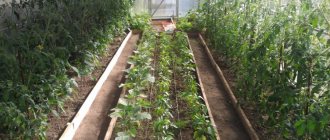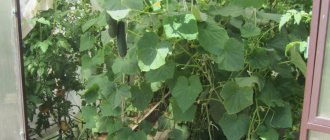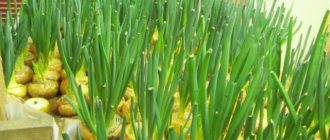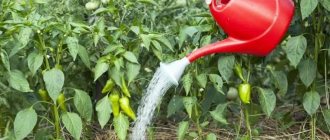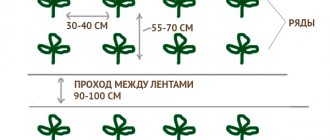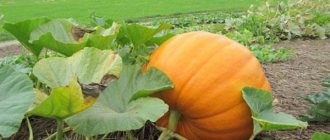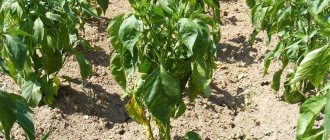Planting peppers and eggplants: about the compatibility of vegetables
If you want to plant two different crops next door, you definitely need to find out their compatibility, which is based on these principles:
1) To what height can the plant grow? This is important because cultures should not overshadow each other and interfere with growth and development;
2) Suitable percentage of air humidity;
3) Suitable ambient temperature;
4) Sufficient soil moisture;
5) Time of fruit ripening.
If we compare the requirements of pepper and eggplant, we can conclude that they are ideal for each other as neighbors. They both love warmth, light and moist soil. Both do not like drought, frost and cold drafts. And the ideal temperature for both is around twenty-five to twenty-eight degrees.
Where to place the seedlings?
Boxes with seedlings or containers with cups are most often placed on spacious window sills of south-eastern and south-western windows . Young sprouts need bright light and not too long daylight hours. The optimal mode is bright diffuse lighting from 8 am to 8 pm. At night, the lamps are turned off and the seedlings are covered with opaque material.
In order for young shoots to feel comfortable, you need to carefully seal all the cracks in the window, eliminating drafts . It is better to cover hot radiators with damp thick towels. The ideal temperature for pecking seeds is 25-28 degrees, after germination it is reduced to 22-25.
Every 3 days, the boxes with seedlings are rotated so that the sprouts are illuminated evenly. You should avoid direct sun exposure to the delicate leaves, especially after watering. Refracting in drops of water, the rays can burn fragile plants.
After permanent leaves appear, the plantings need to be ventilated . At first the photo opens for a few minutes, then for an hour or more.
With the onset of warmth, the grown seedlings are taken out to the balcony or veranda and left there for the whole day. This hardening strengthens young plants and prepares them for transplanting.
How to stratify the soil
These crops love fertile soil rich in microelements, macroelements and nutrients. But even if the soil is suitable, it still needs to be fertilized in order for the crops to actively grow and develop. For one square meter of the selected location, you need to add:
1) Two or three full glasses of wood ash (it is important that the ash is clean, not from painted, varnished or glued wood);
2) One tablespoon - potassium sulfate;
3) One tablespoon - superphosphate;
4) One teaspoon - urea.
After adding such a layer, you need to dig up and level the ground. Such feeding will give impetus to the seedlings for rooting and growing green mass, because it contains all the necessary macroelements, microelements and nutrients.
Soil for seedlings
To get strong seedlings, you need to pay due attention to the health of the soil. The soil is prepared from a mixture of:
- land;
- peat;
- sand, in equal proportions.
You can plant eggplants and peppers in this soil. It is recommended to take peat from the lower layers, as it is less acidic. If they are taken from the upper layers, then it is important to add ash or lime as a deoxidizing agent. At the same time, the soil is still enriched with phosphates.
The sand in this mixture functions as drainage, which is important for the proper formation of plants. If the soil is too acidic, you can add dolomite flour at the rate of 15 g per 1 kg of soil. It would not be superfluous to add fertilizers containing magnesium to the mixture. This approach to soil preparation will allow you to grow seedlings 2 weeks ahead of schedule.
About care
Loosening the soil around crops is not recommended. But if such a need arises, you need to do it very carefully. After all, their root system has a superficial type of location, that is, it is very close to ground level and is quite easily damaged when loosening.
To maintain the required level of air exchange, as well as protect the plantings from weeds, you can resort to mulching. You can mulch with these materials:
1) Sawdust;
2) Dry straw;
3) Dried cut grass;
4) Peat.
The better the quality of the mulching material, the more beneficial properties it will bring. Mulching will also help retain moisture in the soil.
When to plant eggplants in a greenhouse
Eggplants grow only in warm conditions: the most comfortable temperature for them is from 20 to 30 °C; at temperatures below 15 °C, growth stops, and when it cools down to 0 °C, the plants die completely. In greenhouses, especially those made of polycarbonate, ideal conditions are created for them, but even here the temperature must be carefully monitored: overheating is also harmful; in extreme heat, flowers are not pollinated and fall off.
It is difficult to name the exact time when eggplant seedlings should be planted in a greenhouse (namely seedlings: it will not be possible to grow them from seeds even in a heated greenhouse; seeds for seedlings are sown in winter). To start planting, both the seedlings and the greenhouse must be ready: both the beds in it and the temperature conditions.
Ideal seedlings meet the following conditions:
- has about 8 leaves,
- seedling height - 15–20 cm,
- the stem reaches a thickness of at least 5 mm.
The seedlings should have well-branched roots, but it is better not to see this: they must be planted with a large lump of earth, without disturbing the root system. This situation is typical for seedlings about 2.5 months old. At least, earlier than 2 months, no manipulations to remove seedlings from a box or cups are categorically recommended. Eggplants should bloom in a permanent place.
It is advisable to grow each seedling in a separate container: this way it is easier to avoid damaging the root system during transplantation
As for the temperature background, here you need to pay attention to both the air temperature in the greenhouse and the condition of the soil:
- The soil should warm up to at least 15 °C. But it’s better - up to 18–19 oC.
- The air temperature, accordingly, is in no way lower than 18 °C, and better - from 20 °C.
Of course, in a heated greenhouse such conditions can be created at any time, but if we are talking about greenhouses without heating, then the timing of planting seedlings depends on the quality of the greenhouse and the climatic characteristics of the region. In the middle zone, the desired temperature regime occurs approximately in mid-May, in the north - a little later, in the south - in April. But in the southern regions, starting somewhere from the Lower Volga, the use of greenhouses for growing eggplants is not mandatory. In general, the timing has to be adjusted depending on the current weather.
Popular varieties of eggplant from the best producers:
